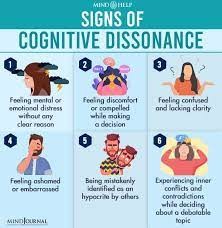
Cognitive dissonance: What to know!
Cognitive dissonance is a theory in social psychology. It refers to the mental conflict that occurs when a person’s behaviors and beliefs do not align.
It may also happen when a person holds two beliefs that contradict one another.
Cognitive dissonance causes feelings of unease and tension, and people attempt to relieve this discomfort in different ways. Examples include “explaining things away” or rejecting new information that conflicts with their existing beliefs.
What is cognitive dissonance?
The psychologist Leon Festinger published his theory of cognitive dissonance in his 1957 book, A Theory of Cognitive Dissonance.
Festinger proposed that people experience discomfort when they hold conflicting beliefs or when their actions contradict their beliefs.
Since then, cognitive dissonance has become one of the most influential and researched theories in social psychology.
People will try to reduce this dissonance to relieve the discomfort. The drive to resolve dissonance is called the “principle of cognitive consistency.”
It is important to note that cognitive dissonance is not automatic when a person holds opposing beliefs. They must have an awareness of the inconsistency to feel discomfort.
Not everyone experiences cognitive dissonance to the same degree. Some people have a higher tolerance for uncertainty and inconsistency and may experience less cognitive dissonance than those who require consistency.
Other factors that affect the degree of cognitive dissonance that a person experiences include:
- The type of beliefs: Beliefs that are more personal lead to more significant dissonance.
- The value of the beliefs: Beliefs that people hold in high regard tend to cause greater dissonance.
- The size of the disparity: A substantial disparity between conflicting and harmonious beliefs will result in more dissonance.
Effects
Cognitive dissonance has the immediate effect of causing feelings of discomfort and unease.
As people generally have an innate desire to avoid this discomfort, cognitive dissonance has a significant effect on a person’s:
- behaviors
- thoughts
- decisions
- beliefs and attitudes
- mental health
People experiencing cognitive dissonance may notice that they feel:
- anxious
- guilty
- ashamed
As a result, they may:
- try to hide their actions or beliefs from others
- rationalize their actions or choices continuously
- shy away from conversations or debates about specific topics
- avoid learning new information that goes against their existing beliefs
- ignore research, newspaper articles, or doctor’s advice that causes dissonance
Avoiding factual information can allow people to continue maintaining behaviors with which they do not fully agree.
Of course, cognitive dissonance may prompt some people to change their behavior so that their actions align with their beliefs. In this way, it provides people with an opportunity to examine their values and actions and achieve cognitive consistency.
As a result of cognitive dissonance, many people confront problematic attitudes and actions.
They may make positive changes in their lives, such as addressing unhealthful eating habits, addiction, or anger issues.
Examples
Situations where cognitive dissonance can occur include:
- Smoking despite being aware of the adverse health effects of tobacco use.
- Choosing to promote a behavior, such as regular exercise, that a person does not themselves practice. This type of cognitive dissonance is called hypocrisy.
- Telling a lie despite the person thinking of themselves as honest.
- Purchasing a new car that is not fuel efficient, despite being environmentally conscious.
- Eating meat while also thinking of themselves as an animal lover who dislikes the thought of killing animals. Some researchers call this the meat paradox.
Find a mental health provider from BetterHelp's wide network for your everyday needs. Take a quiz, get matched, and start getting support via phone or video. Plans start at $60/week + an additional 20% off.
How to resolve cognitive dissonance
People who experience cognitive dissonance can take steps to reduce it. They may do this by:
Rejecting or avoiding conflicting information
Often, people resolve cognitive dissonance by devaluing and discarding conflicting knowledge.
They may limit their exposure to new information that does not align with their existing beliefs — a phenomenon called “confirmation bias.”
One example of this is devaluing particular news sources by describing them as biased or false.
Read more here:
Be the mirror, not the reflection.
1yWhat's even worse is when you're fully aware, but you're forced into a thinking pattern completely contrary to your beliefs. In that environment, Sanctions like job loss are meted out when you don't think the correct thoughts and let it be known. Unfortunately, we're now surrounded by such environments with seemingly no hope to escape from them. Your only choices are either to keep your mouth zipped or to land on the street. For people who are, by temperament or cognitive insight, more inclined to question their surroundings it's a very unhealthy environment. And yes, those feelings mentioned above are the desired effect by the ones with power over you. It keeps you compliant and quiet.
Diversely Experienced Electrical Engineer - Consultant, Researcher, Inventor, Technologist, Author, and Dot-Connector Extraordinaire
1yyes, many are feeling it, especially the politicians - but they themselves busy with mind numbing busyness so that they don't have to confront it. But the long they wait, the harder it will be to reconcile with it. Dissonance unattended grows over time.
I have an intense curiosity to find out why people do not revolt against the yoke they work under - whether it's opinions of others or ...
1ySelf knowledge will help avoid these pitfalls
Aviation Consultant / Ground Operations & Airport Services Management Specialist / Author /World Rugby Qualified Coach & Referee
1yCognitive dissonance is explained in this article in a very clear and concise way.
I like this one too